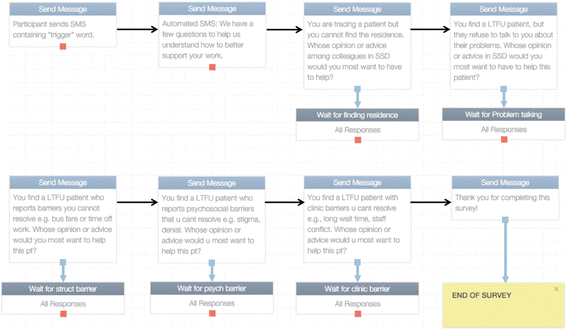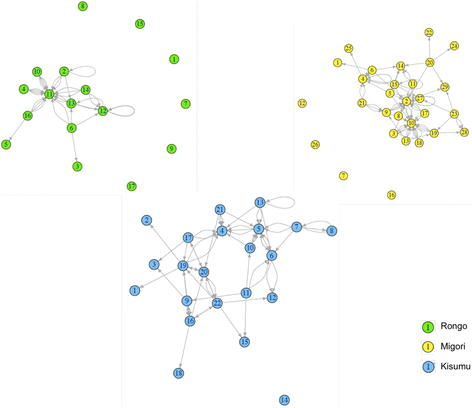Rapid sociometric mapping of community health workers to identify opinion leaders using an SMS platform: a short report
- PMID: 28651602
- PMCID: PMC5485544
- DOI: 10.1186/s13012-017-0611-y
Rapid sociometric mapping of community health workers to identify opinion leaders using an SMS platform: a short report
Abstract
Background: Using opinion leaders to accelerate the dissemination of evidence-based public health practices is a promising strategy for closing the gap between evidence and practice. Network interventions (using social network data to accelerate behavior change or improve organizational performance) are a promising but under-explored strategy. We aimed to use mobile phone technology to rapidly and inexpensively map a social network and identify opinion leaders among community health workers in a large HIV program in western Kenya.
Methods: We administered a five-item socio-metric survey to community health workers using a mobile phone short message service (SMS)-based questionnaire. We used the survey results to construct and characterize a social network of opinion leaders among respondents. We calculated the extent to which a particular respondent was a popular point of reference ("degree centrality") and the influence of a respondent within the network ("eigenvector centrality").
Results: Surveys were returned by 38/39 (97%) of peer health workers contacted; 52% were female. The median survey response time was 13.75 min (inter-quartile range, 8.8-38.7). The total cost of relaying survey questions through a secure cloud-based SMS aggregator was $8.46. The most connected individuals (high degree centrality) were also the most influential (high eigenvector centrality). The distribution of influence (eigenvector centrality) was highly skewed in favor of a single influential individual at each site.
Conclusions: Leveraging increasing access to SMS technology, we mapped the network of influence among community health workers associated with a HIV treatment program in Kenya. Survey uptake was high, response rates were rapid, and the survey identified clear opinion leaders. In sum, we offer proof of concept that a "mobile health" (mHealth) approach can be used in resource-limited settings to efficiently map opinion leadership among health care workers and thus open the door to reproducible, feasible, and efficient empirically based network interventions that seek to spread novel practices and behaviors among health care workers.
Figures





References
-
- Valente T, Davis R. Accelerating the diffusion of innovations using opinion leaders. Ann Am Acad Pol Soc Sci. 1999;566(1):55–67. doi: 10.1177/0002716299566001005. - DOI
-
- Coleman J, Katz E, Manzel H. The diffusion of an innovation among physicians. Sociometry. 1957;20(4):253–70. doi: 10.2307/2785979. - DOI
-
- Valente T. Network models and methods for studying the diffusion of innovations. Models Methods Soc Netw Anal. 2005;2005:98–116. doi: 10.1017/CBO9780511811395.006. - DOI
Publication types
MeSH terms
Grants and funding
LinkOut - more resources
Full Text Sources
Other Literature Sources
Medical
Miscellaneous

